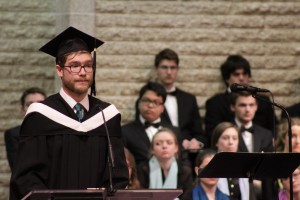In April 2014, Scott Sawatzky graduated from Canadian Mennonite University, with a Bachelor of Arts in English and a minor in Psychology. He delivered the valedictorian address and was also awarded the President’s Medal for leadership and outstanding academic achievement.
The aspiring teacher was soon accepted into the University of Winnipeg’s Bachelor of Education program. Sawatzky, who has been volunteering with a youth group in his hometown of Niverville for the past four years, says he “absolutely” believes his practicum experience and other youth-work experience had a definitive impact on his eligibility for the B. Ed. Degree, and ultimately, his readiness for a career in the classroom:
“It was actually a little surprising to me how much they looked at it,” Sawatzky says. “Or rather how important it was to the Education Department that you had experience with youth.”

During his third year, after a recommendation from one of CMU’s practicum coordinator’s, Sawatzky requested to be placed at St Aidan’s Christian School—a funded independent middle school for grades five through nine in the Point Douglas neighbourhood of Winnipeg’s North end.
He reflects: “When it was described it to me—this little school in the north end serving inner-city kids—I thought, “sounds scary…sure! ”
Sawatzky goes on to outline the many ways in which he feels his CMU practicum experience helped prepare him for the work he plans to do, and expresses his gratitude:
“Firstly, doing my practicum at a very small, independent school helped me realize that I could teach in a variety of different contexts: private schools, public schools, tutoring agencies, etc. There are fewer limits than I’d thought.”
“Beyond that, it gave me face time in a classroom, which was very helpful. I was serving basically as a TA, so I got to enjoy a lot of positive interaction with students through learning moments, or hanging out during breaks, etc. It also put me through challenging situations, like confrontations with students, opportunities to learn from mistakes. Basically, it all helped me gain valuable experience.”
When asked why he hesitates to mention how student demographics influenced his experience, Sawatzky is very deliberate:
“I think one really important thing that placement did for me, was it saved me from any kind of Saviour complex that a teacher might be prone to fall into; and that was because I was never able to pigeon-hole these kids in my mind as “inner-city” students. While many of them had the kinds of disturbing back-stories that one might normally think of, most of the students were from basically stable, loving homes—and even the ones who were from difficulties were, between them, very diverse. I realized by the end that I was one very small part of their lives and it wasn’t up to me to make or break them, only to be as good an influence as I could in the role that I was filling. I think being forced to acknowledge each of them as unique, really kept me humble and will help me stay that way in future.”
By Beth Downey
